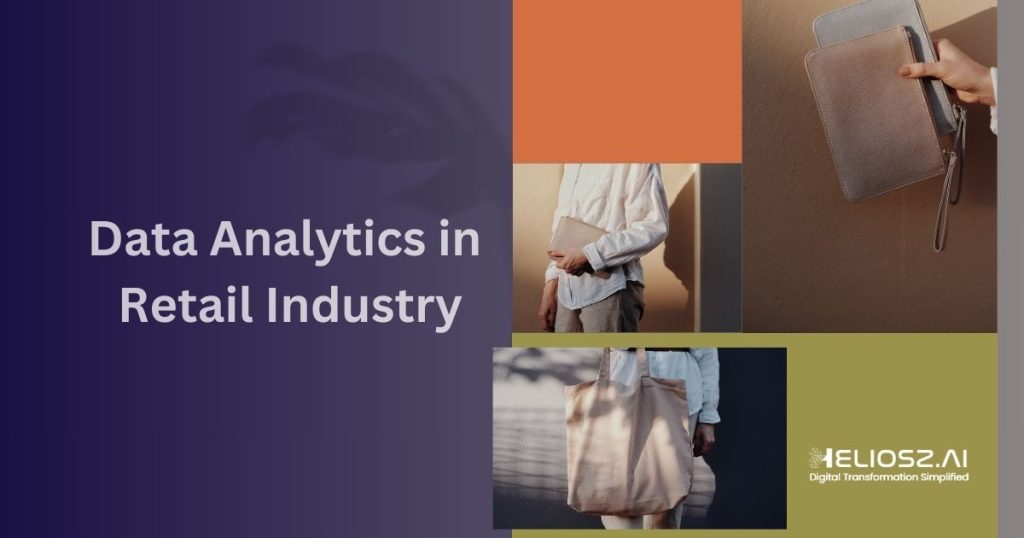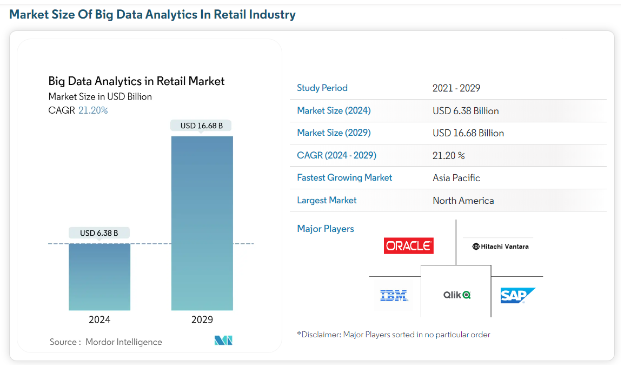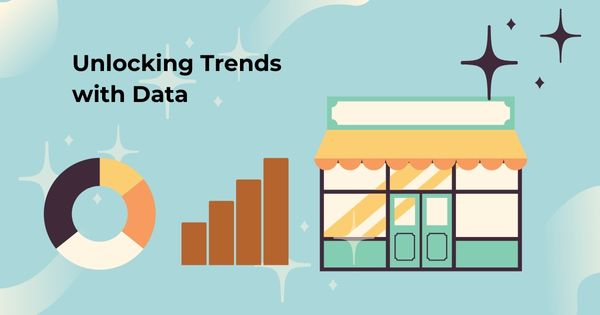
The digitally driven world of business which undergoes seismic changes in consumer behavior, preferences, technological trends, and much more in an agile manner demands data analytics in retail industry.
The drastic shift in e-commerce markets, interest towards customized shopping experiences, etc. are some key factors that underscore the cruciality of analyzing customer data, purchase history, feedback, behavioral trends, and more big data elements to optimize business operations. Data Analytics in retail is not just an advantageous approach but essential for sustainability and growth.
This article will make you travel through significant topics relevant to the most asked question in the current business world- “How is data analytics used in the retail industry?”
Table of Contents
- The Booming Retail Analytics Market
- 5 Benefits of Using Data Analytics in Retail Industry
- 6 Important Ways How Data Analytics Used in the Retail Industr
- Heliosz.ai: Your Trusted Data Solutions Partner
The Booming Retail Analytics Market
Heard of this interesting study of big data analytics in the retail industry?
A recent study by Mordor Intelligence paints a clear picture: the big data analytics market in retail is on an upward trajectory, expected to reach a staggering $16.68 billion by 2029, with an annual growth rate exceeding 21%. This explosive growth signifies the immense value retailers place on data-driven decision-making.

5 Benefits of Using Data Analytics in Retail Industry
1. Enhanced customer data analytics in retail and insights study for stronger customer relationship
Customers or consumers are the most crucial element in any business. Data analytics enables retailers to obtain an understanding of consumer behavior, customer preferences, purchasing trends, and product selection patterns easily. By analyzing historical data, and all other important customer data, retailers can segment customers, and tailor products and services suitable to their preferences. This will ultimately lead to a solid customer relationship and improve revenue potential.
2. Optimized inventory management to minimize stockouts and improve profitability
Efficient inventory management is a key to successful sales. Data analytics that includes sales data analysis, study on seasonal trends, supplier performance, vendor efficiency, and demand analysis will help organizations plan inventory levels. Data analytics in the retail industry will ensure that inventories are efficiently managed and avoid situations of stockouts, excess inventory procurement, and imbalanced product purchases. Consequently, this will be reflected in effective cash flow and increased profitability.
3. Dynamic and fair pricing strategies implementation
Data analytics assists retailers in establishing fair and dynamic pricing strategies based on current market trends. The retail analytics will provide a clear report on real-time market conditions, competitor analysis, customer demands, raw material pricing changes, and all fluctuations regarding the market pricing structure. This price analytics report plays a major role in adjusting pricing to maximize revenue, drive sales, and remain competitive by providing a fair price structure for customers. A win-win strategy!
4. Streamlined operations in business
From supply chain management to store operations, retail analytics enables retail businesses to streamline entire processes. A well-developed data analytics framework results in the identification of inefficiencies, optimization of staffing levels, improved store layouts, and enhanced overall efficiency.
5. Fraud detection and prevention for saving brand reputation
Digitalized business activities are susceptible to fraud practices and significant threats. Data analytics in the retail industry allows retailers to identify transactional data, suspicious activities, and fraudulent patterns. Ultimately, organizations can implement proactive measures to prevent any deceptive actions. This will safeguard both revenues and brand reputation.
6 Important Ways How Data Analytics Used in the Retail Industry

There are a multitude of ways data analytics in the retail industry is used for creating actionable insights for C-suite executives and decision-makers. Here is the breakdown of each way for a clear understanding of the worth of investing in a well-defined data analysis strategy for retail business.
1. Predictive Data Analytics in Retail
To forecast future trends, customer behavior prediction in retail, and possible consequences, predictive analytics makes use of statistical algorithms and historical data. The analysis includes examining outside variables that may have an impact on retail companies directly or indirectly, such as the climate, prevailing economic trends, and patterns in the worldwide market. Demand, retail sales forecasting, inventory, and resource efficiency are all made easier in the retail sector by predictive analytics. Retailers may better manage inventory levels and price strategies by anticipating client demand changes and sales surges with the help of this analytical data.

2. Customer Segmentation and Targeted Marketing: Data Analytics in Retail
Customer segmentation is the process of sorting customers into groups based on their demographics, buying behavior, shopping preferences, and online habits. It helps businesses target their marketing efforts more effectively by delivering the right product recommendations to the right customers at the right time through personalized messages.
Consequently, retailers may craft specific sales and marketing offers such as discounts, marketing messaging, product recommendations, and loyalty programs among others; thereby raising profitability and efficiency levels of sales promotion projects. Normally, customization in advertising results in raised satisfaction levels and profitability among customers.
3. Market Basket Analysis
Market basket analysis is a data mining technique to examine the relationship between products purchased by customers. This will enable retailers to understand the patterns and associations of basket products. The fundamental goal of conducting market basket analysis is to analyze the data of specific products that are bought together and place them in the nearby vicinity in stores and online platforms.
For example, a simple association rule might state: “Customers who purchase bread are 70% likely to also purchase milk.” This indicates a strong association between bread and milk in customer transactions, with a confidence level of 70%. Market basket analysis will enable cross-selling and upselling opportunities, product placement plans, promotional campaigns, and inventory management.
4. Sentiment Analysis
Sentiment analysis is the process of analyzing sentimental data from customers such as customer reviews, social media posts, online surveys, online communities, etc.
This analysis involves a series of steps for opinion mining using advanced natural language processing and machine learning algorithms. Retailers leverage sentiment analysis reports to monitor brand reputation, understand customer response (feedback, preferences, and emotions), identify emerging trends, and address customer concerns promptly.
5. Real-time Analytics
Real-time analytics involves the strategies to process and analyze data when it is generated. This will allow retailers to make timely decisions and respond proactively to the market conditions based on the actionable data. Real-time analytics offer insights into sudden fluctuations in sales, inventory levels, supply chain gaps, and customer behavior that demands immediate attention and decisions to be taken in no time.
6. In-store Analytics
In-store analytics is a critical use of data analytics in the retail sector. The main goals of this are to optimize retail operations and analyze consumer behavior. Retailers use technology like Wi-Fi tracking and video analytics to gather information on foot traffic, dwell time, and consumer interactions within the store.
Retailers can learn more about how customers move through the shop, which areas get the most interest, and which products are seen or bought most often by using in-store analytics. This analysis will shed light on the best practices for visual merchandising, personnel levels, product display placements, and shop layouts. Retailers can also use in-store analytics to find operational inefficiencies like long checkout lines and stockouts.
Frequently Asked Questions about Data Analytics in Retail
How do Retailers Use Data Analytics to Improve Customer Experience and Drive Sales?
Data analytics is utilized by retailers to be able to present a quality shopping experience and increase sales in the long run by examining customers’ habits, behaviors, and trends. It can perform optimization, assess inventory utilization, and revise pricing strategies that help bring down customer demand and improve sales and hence the customer retention rate by developing personalized strategies for selling and engagement through digital marketing channels mostly via data-based choices, catering to the needs of the customer and achieving satisfaction through higher sales and loyalty.
Why Retailers Fail to Adopt Advanced Data Analytics in Retail?
Retailers can fail to apply the advanced data analysis within their infrastructure as they miss the awareness of benefits, shortage of implementation resources, fears of the change, increased concerns about privacy and security of data and the adverse reaction to enabling new technologies with their organization. On top of that, good adoptions need to solve not only significant data integration issues, but they also face cultural problems inside the organization and a lack of experienced personnel in charge.
How to Use Data Analytics in Retail to Boost Sales?
Total sales can be multiplied excellently through the utilization of retail data analytics. Primarily, research can be made easier by data collection and analysis of the behavior and choices of the customers. The trend, in this case, could be lovely pieces of cloth that suit your customer’s needs. The seller will make double the money when customers buy all the available products. Also, the seller will make more money through the pricing strategies. The seller will make more money from the promotions too. Finally, a salesperson will be able to monitor the level of stock.
Heliosz.ai: Your Trusted Data Solutions Partner
Heliosz.ai goes beyond simply providing data – we empower you to harness its true potential. We have deep expertise in data analytics in the retail industry with popular retailers around the world. We help retailers thrive in the super competitive data-driven business landscape. We have a proven track record of helping retailers achieve significant improvements in customer experience, operational efficiency, and profitability.
Final Thoughts
For retail industry leaders and decision-makers, leveraging the potential of data analytics is more than a trend; it is a strategic imperative. It is about gaining a deeper understanding of customers, streamlining operations, and increasing revenue.
Stay competitive in this hypercompetitive business world where business growth is reigned by data-driven decisions. With trusted and adept data solutions partners like Heliosz.ai besides, you can climb the ladder of success.
Schedule a call with our expert team and learn the capabilities of Heliosz.ai to tackle data analytics challenges in your retail business.


